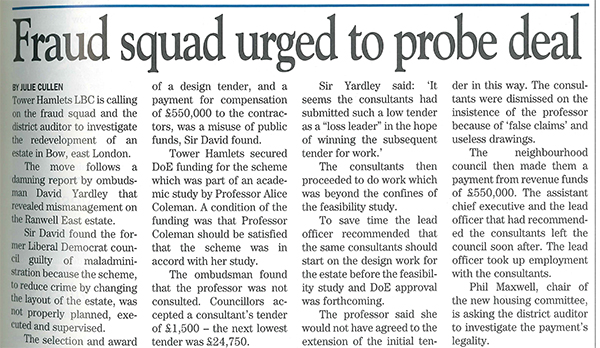You are viewing 1 of your 1 free articles
From the archive – demand for social housing set to fall
Inside Housing looks back at what was happening in the sector this week five, 15 and 25 years ago
25 years ago
Tower Hamlets Council called on the fraud squad and the district auditor to investigate the redevelopment of an estate in Bow, east London.
The moved followed a report by ombudsman Sir David Yardley that revealed mismanagement on the Ranwell East Estate.
Sir David found that the former Liberal Democrat council was guilty of maladministration because a plan to reduce crime by changing the layout of the estate had not been properly planned, executed or supervised.
The selection and award of a design tender and a payment for compensation of £550,000 to the contractors was a misuse of public funds, Sir David found.
The council had failed to meet conditions of funding for the scheme and appointed consultants who were unable to carry out the work.
15 years ago
Research carried out for Inside Housing and the Chartered Institute of Housing (CIH) found that the number of people living in social housing could fall dramatically over the following 20 years, impacting housing providers’ development and viability.
The research warned that social landlords could be left with too much of the wrong type of housing as estates became dominated by very young and much older people.
As more people moved to the private rented sector or bought homes, the number of people living in the social sector could fall by 179,000 by 2021, it said, leading to a big reduction in the number of new social homes needed each year.
Sarah Webb, then-chief executive of the CIH, said housing providers would need to reinvent themselves as neighbourhood managers of mixed-tenure areas, and that there could be a “clear retraction” in the sector.
But she added that the main challenge would be rebranding social housing as a “tenure of choice rather than a tenure of last resort”, and that planning for the future would remain very difficult.
Picture: Getty
Five years ago
The proportion of new social housing lets going to black and minority ethnic (BME) households in England dropped by almost a quarter over an 18-month period, leading to concerns about the way social housing was being allocated.
Lets to BME households dropped from 17.3% of total lets in June 2012 to 13.2% in December 2013, while lets to white households rose from 75.2% to 82.3% over the same period, according to data collected by the Department for Communities and Local Government.
A separate survey of 25 large associations found the same trend.
It was unclear what was causing the shift, although some blamed changes to council allocation policies which allowed some local authorities to prioritise working households.










